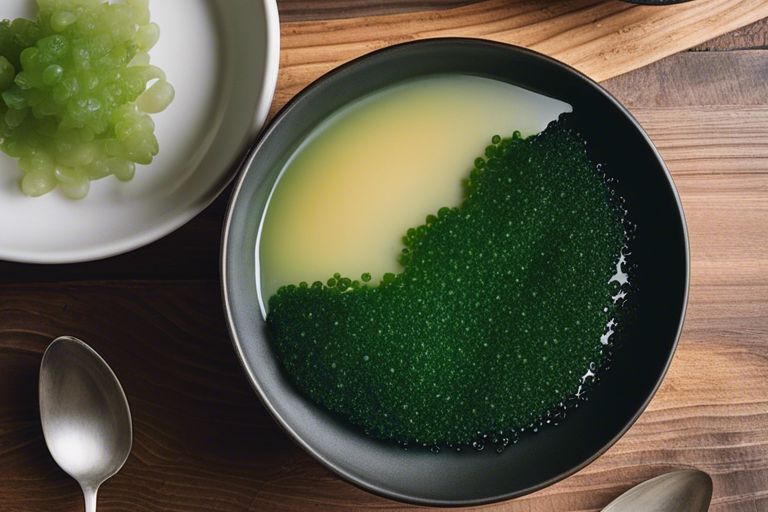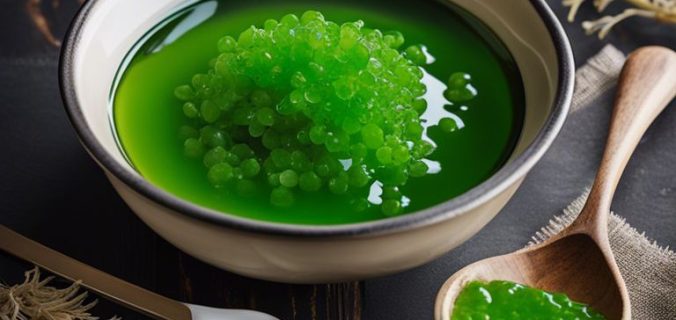Seaweed, a versatile ingredient, can be transformed into a delectable plant-based caviar using the power of agar agar in the comfort of your own kitchen. This innovative recipe offers a sustainable and cruelty-free alternative to traditional caviar, packed with imperative nutrients and bursting with flavor. By following these simple steps, you can impress your guests with an elegant and environmentally friendly delicacy that will elevate any dish it graces. Let’s examine the exciting world of plant-based cuisine and learn how to create your own seaweed and agar agar caviar from scratch.

Key Takeaways:
- Plant-Based Alternative: Creating caviar from seaweed and agar agar offers a sustainable and vegan-friendly alternative to traditional fish caviar.
- Creative Culinary Technique: The process of transforming seaweed and agar agar into caviar pearls involves innovative culinary techniques that can elevate dishes and add a unique texture and flavor.
- Customizable Flavors and Colors: Experimenting with different seaweed varieties, flavorings, and natural colorants allows for the customization of plant-based caviar to suit individual tastes and preferences.
Essential Ingredients and Tools
Little do most people know that creating plant-based caviar at home is not only possible but also quite simple. For a detailed recipe, you can refer to this 5-Ingredient Vegan Caviar Recipe.
Understanding Seaweed Varieties
With a variety of seaweed options available, it’s important to choose the right type for your plant-based caviar. Each seaweed variety offers a unique texture and flavor profile, from the salty notes of dulse to the more delicate taste of nori.
The Role of Agar Agar in Plant-Based Caviar
Plant-based caviar relies on agar agar as a gelling agent to create the characteristic caviar texture. Agar agar, derived from seaweed, is a natural and vegan-friendly alternative to gelatin. Its gel-forming properties make it ideal for caviar production.
Another crucial aspect of using agar agar in plant-based caviar is its ability to set quickly at room temperature. This feature allows you to form perfect caviar spheres without the need for excessive chilling or special equipment.
Kitchen Tools You’ll Need
Role the following kitchen tools play a critical role in creating plant-based caviar: a fine mesh strainer, dropper or syringe for shaping the caviar, a small saucepan for heating the ingredients, and a spoon for gently dropping the caviar mixture into the setting solution.
The precision and speed with which you handle these tools can affect the outcome of your final product. It is crucial to work efficiently and attentively to achieve the desired results.
Preparing the Seaweed Base
Cleaning and Soaking Techniques
To start creating your plant-based caviar from seaweed and agar agar, you need to first ensure that the seaweed is cleaned properly. Even though dried seaweed may look clean, it is crucial to wash it thoroughly to remove any impurities or salt residue that may affect the final taste of your caviar. Soaking the cleaned seaweed in water for the recommended time will help rehydrate it and prepare it for the next steps in the process.
Tips for Infusing Flavors
Infusing flavors into your plant-based caviar can elevate the taste and create a unique culinary experience. Experimenting with different ingredients such as herbs, spices, citrus zest, or even truffle oil can add depth and complexity to your caviar. To infuse flavors successfully, consider the intensity of the ingredients you are using and how they will complement the overall dish. Knowing when to add the flavors and in what form is key to achieving a harmonious blend in your caviar.
The Agar Agar Transformation
Mastering the Agar Agar Mixture
Unlike traditional caviar, plant-based caviar made from seaweed and agar agar requires meticulous attention to the agar agar mixture. The agar agar powder must be dissolved in the appropriate liquid, typically water or vegetable broth, and heated to a specific temperature to activate its gelling properties. Once mastered, this step is crucial for creating the desired texture of the caviar.
Factors Affecting the Setting Process
The setting process of agar agar can be influenced by various factors. These include the acidity of the liquid used, the ratio of agar agar to liquid, and the temperature at which the mixture cools. Understanding how each factor affects the setting process is important for achieving the perfect consistency of plant-based caviar.
- Acidity of the liquid used
- Ratio of agar agar to liquid
- Temperature at which the mixture cools
Clearly, these factors play a critical role in the successful creation of plant-based caviar. Mastering the art of controlling these variables will ensure a flawless final product.
Agar Agar
Agar agar, a plant-based gelatin derived from seaweed, possesses remarkable gelling properties that make it a popular choice for vegan culinary creations. Its ability to set at room temperature makes it a convenient and versatile ingredient for making caviar. However, it is crucial to follow precise measurements and techniques to achieve the desired texture and appearance of the caviar. Furthermore, agar agar is heat-sensitive, so careful attention must be paid to the temperature during the setting process to avoid inconsistencies.
Shaping the Perfect Plant-Based Pearls
How-To: Dropping Technique for Caviar Beads
Keep in mind that the key to achieving the perfect plant-based caviar pearls lies in mastering the dropping technique. Clearly understand the viscosity of the agar agar mixture to control the size of the droplets. Use a dropper or syringe to release small, consistent droplets into the cold oil bath for optimal shape and texture.
Tips for Consistent Size and Shape
Size and shape consistency are crucial when making plant-based caviar. It is crucial to maintain uniformity to ensure an appealing presentation and consistent texture. Here are some tips to help you achieve that:
- Use a calibrated dropper for precise measurements.
- Chill the agar agar mixture thoroughly before dropping to prevent spreading.
- Practice the dropping technique on a small scale before creating larger batches.
Knowing the right consistency and temperature of the agar agar mixture is key to achieving consistent size and shape in your plant-based caviar pearls.
Storage and Serving Suggestions
The Best Ways to Preserve Your Caviar
Your plant-based caviar made from seaweed and agar agar can be preserved effectively by storing it in an airtight container in the refrigerator. Make sure to cover the caviar with a thin layer of olive oil before sealing the container, as this will help maintain its freshness and prevent it from drying out. It is recommended to consume the caviar within a week to enjoy it at its best.
How to Incorporate Your Creation into Dishes
If you want to elevate your dishes with a touch of luxury, consider incorporating your plant-based caviar into various recipes. Add a pop of umami flavor to sushi rolls, salads, or avocado toast by topping them with a spoonful of your homemade caviar. You can also use it as a garnish for soups, pasta dishes, or canapés to add a tantalizing texture and visual appeal.
Incorporate your plant-based caviar thoughtfully into dishes to create a gourmet experience for your taste buds. Experiment with different flavor combinations and presentation styles to make your creations stand out and impress your guests, or simply enjoy it as a delightful indulgence for yourself.
Final Words
Hence, creating plant-based caviar from seaweed and agar agar at home is a simple yet innovative process that allows you to enjoy the luxurious experience of caviar without harming marine life. By following the step-by-step guide provided and experimenting with different flavors and textures, you can elevate your culinary skills and impress your guests with a sustainable and flavorful alternative. Embrace this unique culinary adventure and discover the endless possibilities of creating your own plant-based caviar from the comfort of your own kitchen.
FAQ
Q: What ingredients do I need to create plant-based caviar from seaweed and agar agar at home?
A: To make plant-based caviar, you will need the following ingredients: seaweed (such as agar agar), a liquid base (such as vegetable broth or fruit juice), flavorings (such as soy sauce or vinegar), and a setting agent (such as calcium chloride or sodium alginate).
Q: How do I make plant-based caviar using seaweed and agar agar?
A: To create plant-based caviar from seaweed and agar agar at home, follow these steps: hydrate the seaweed in a liquid base, heat the mixture to dissolve the agar agar, add flavorings to the mixture, strain the mixture into a caviar-making tool, and set the caviar in a setting agent bath. Once set, you can spoon out the plant-based caviar and enjoy!
Q: Can I customize the flavor and texture of plant-based caviar made from seaweed and agar agar?
A: Yes, you can customize the flavor and texture of plant-based caviar by experimenting with different liquid bases, flavorings, and setting agents. For example, you can use beet juice for a vibrant color, add truffle oil for a rich flavor, or use different setting agents to achieve various textures. Get creative and tailor your plant-based caviar to your taste preferences!


Pingback: Plant-Based Seafood - Healthy And Delicious Alternatives To Try - Veganism